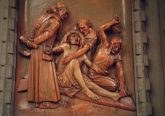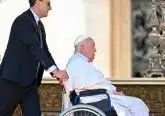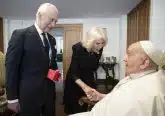Invalid baptisms: A Catholic explainer about the facts and the fears
Denver Newsroom, Feb 11, 2022 / 17:19 pm
Baptism involves a simple formula: “I baptize you in the name of the Father, the Son, and the Holy Spirit.” The celebrant pours water on the head of the baptized, or immerses them in water. Usually, Catholic clergy are responsible for baptisms. But anybody can baptize in an emergency, as in cases where a prospective Christian, even an infant, is in imminent danger of death.
Sometimes, people mess with this formula. Many of them mean well, but that can have consequences. In rare cases, Catholic clergy weren’t baptizing using the form of the baptismal rite approved by the Church.
This has prompted some questions and some worries. Here’s what you need to know:
Have some clergy really been baptizing Catholics incorrectly?
In August 2020 the Congregation for the Doctrine of the Faith, in a document approved by Pope Francis, said that Catholics who use the phrase “we baptize” when they try to baptize someone don’t get the job done. In Church parlance, it is an “invalid” baptism.
In effect, saying “we baptize” tries to baptizes someone “in the name of the community.” Who is the baptizer here? It’s too vague.
Some clergy would ad lib the baptismal rite. They would use phrases like “In the name of the father and of the mother, of the godfather and of the godmother, of the grandparents, of the family members, of the friends, in the name of the community we baptize you in the name of the Father and of the Son and of the Holy Spirit.”
This sloppy talk has important consequences, the CDF noted. The sacrament cannot be presumed to be valid: these baptisms were not really sacraments, but simply attempts to baptize.
So what happened next?
Cases where a priest or deacon attempted a baptism, but used an invalid form, means re-examining the sacramental life of everyone who thought they were baptized validly.
Most recently, the Diocese of Phoenix announced that a priest had been incorrectly trying to baptize people for over 20 years. The priest, Father Andres Arango, apologized, and the diocese took steps to help those who had been invalidly baptized.
So this is a big deal?
Baptism is definitely a big deal! Christ told believers to be baptized. Baptism washes away both personal sin and original sin.
In the words of the Catechism of the Catholic Church, baptism is “the basis of the whole Christian life, the gateway to life in the Spirit, and the door which gives access to the other sacraments. Through baptism we are freed from sin and reborn as Sons of God; we become members of Christ, are incorporated into the Church and made sharers in her mission.”
If you aren’t baptized, you can’t receive the other sacraments.
In rare cases, there have been invalidly baptized men, who thought they were priests, acting as priests.
After the 2020 announcement from the Vatican, some men who thought they were priests looked back at videos of their own baptisms only to realize that the priest or deacon who baptized them hadn’t followed the basic rite in important ways.
Father Zachary Boazman of Oklahoma City is one such priest. He watched a video from his infancy in which a deacon from the Diocese of Dallas, during service in the Diocese of Fort Worth, had tried to baptize the infant Boazman using the wrong formula.
Father Matthew Hood of the Archdiocese of Detroit also watched a video of a different deacon, Mark Springer, performing an invalid baptism on him as an infant in Troy, Michigan.
In both cases, these would-be priests weren’t really priests, or even Christians! Both men had to be baptized, confirmed, and ordained deacons and then priests for the first time.
Compounding this problem, these men who were mistaken to be priests did not in fact consecrate the Eucharist at the Mass. Their confessions, confirmations, and anointings of the sick weren’t valid.
What did the Vatican have to say about this?
The CDF’s 2020 statement cited the Second Vatican Council document Sacrosanctum Concilium, which said “no one, ‘even if he be a priest, may add, remove, or change anything in the liturgy on his own authority.'”
Those who changed the form of baptism acted with “debatable pastoral motives” which revive “the ancient temptation to substitute for the formula handed down by Tradition other texts judged more suitable.”
So why does “we baptize” not get the job done?
Christ instituted the sacraments and entrusted them to the Church, the CDF emphasized. The Church has safeguarded the celebration of sacraments, “above all in those elements to which Scripture attests and that make it possible to recognize with absolute clarity the gesture of Christ in the ritual action of the Church.”
This baptism controversy is really about recognizing Christ.
When someone administers the sacrament of baptism, the CDF said, “it is really Christ Himself who baptizes.”
An emphasis on parents, godparents, and the community is already present in other parts of the baptismal rite, the CDF noted.
How are Catholics responding to criticism that this is empty legalism that God can work around?
The good news is that Catholic teaching certainly recognizes that God’s grace can work even if the sacraments were not validly conferred.
The “bad news” is that Catholic teaching can’t pretend a sacrament happened if it failed to follow the right form, the right matter, and the right intent.
The Phoenix diocese addressed the charge of legalism in a FAQ on its website:
“It may seem legalistic, but the words that are spoken (the sacramental form), along with the actions that are performed and the materials used (the sacramental matter) are a crucial aspect of every sacrament,” said the diocese. “As a priest may not substitute milk for wine during the Consecration of the Eucharist, nor may he change the words of baptism.”
The Phoenix diocese added: “It is important to note that, while God instituted the sacraments for us, He is not bound by them. Though they are our surest access to grace, God can grant His grace in ways known only to Him. According to St. Thomas Aquinas, God has bound Himself to the sacraments, but He is not bound by the sacraments.”
What about Catholics baptized in non-Catholic Churches or ecclesial communities?
Good news: many, many non-Catholic Churches and ecclesial communities are presumed to baptize validly, if they follow the same formula, use water to baptize, and intend to perform a Christian baptism like Christ and the Catholic Church intend.
How else can a baptism go wrong?
In 2008, the Congregation for the Doctrine of the Faith responded to a question about the validity of certain baptismal formulas which use the phrasing “in the name of the Creator, and of the Redeemer, and of the Sanctifier” or “in the name of the Creator, and of the Liberator, and of the Sustainer.” These phrasings, too, are not a valid baptism and anyone who received such an attempted baptism must receive be baptized before receiving any other sacraments.
These phrasings fail to express the Catholic belief in the Holy Trinity. Sometimes they became popular through feminist motives, which consider “the Father” and “The Son” to be chauvinistic.
“Such variants, however, undermine faith in the Trinity,” the CDF said.
Are there baptisms that seem Christian, but aren’t?
Sometimes! In 2001, the Congregation for the Doctrine of the Faith said that baptism by the Church of Jesus Christ of Latter-Day Saints, informally known as Mormons, is not valid.
At first sight, it seems that Mormons baptize others in the name of the Trinity. But their intention is much different.
“Mormons hold that there is no real Trinity, no original sin, that Christ did not institute baptism,” Father Luis Ladaria, S.J., explained in an Aug. 1, 2001 article for L’Osservatore Romano. Ladaria would go on to head the Congregation for the Doctrine of the Faith under Pope Francis, who made him a cardinal in 2018.
“The words Father, Son and Holy Spirit, have for the Mormons a meaning totally different from the Christian meaning,” Ladaria wrote. “The differences are so great that one cannot even consider that this doctrine is a heresy which emerged out of a false understanding of the Christian doctrine. The teaching of the Mormons has a completely different matrix.”
In the Mormon understanding, baptism was begun by God with Adam, not by Christ. They deny the existence of original sin, and so do not act from the Catholic view that baptism remits both personal and original sin, Ladaria explained. If an LDS member renounces his or her faith or is excommunicated and later wants to return, they require a “re-baptism.”
For Christians, however, baptism is a unique event that can only take place once.
A minister of a Mormon baptism intends to do what the Church of Jesus Christ of Latter-Day Saints means by baptism, not what the Catholic Church means by it.
The Catholic baptism of infants is a main reason the LDS consider the Catholic Church to have apostatized. From their perspective, none of the Catholic sacraments are valid.
How worried should I be? Was my baptism valid?
These news reports can make some Catholics worry that they, too, might not have really been baptized. But if there is no video evidence and no claims that the baptismal officiant had a habit of casually changing the baptismal formula, these worries shouldn’t dominate.
Fr. Thomas Petri, O.P., a moral theologian at the Dominican House of Studies in Washington, D.C., told CNA in August 2020 that it is not unreasonable for anyone who has a video of their baptism to review the tape, just in case.
Memories of a baptism aren’t necessarily reliable, he warned. People in general are prone to misremembering and those present might not have been paying close attention.
“In the vast majority of cases, the vast majority are going to be fine, and valid,” Petri said. He said he suspected that only a “very small percentage” of presumed baptisms are invalid.
He repeated Catholic teaching that God guarantees the sacraments, but he himself is not bound by them.













